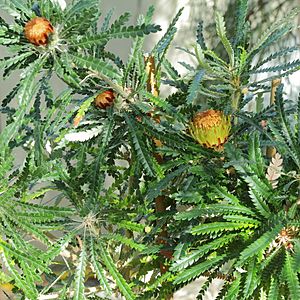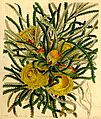Showy dryandra facts for kids
Quick facts for kids Showy dryandra |
|
|---|---|
 |
|
| Flowers and foliage | |
| Scientific classification | |
| Genus: |
Banksia
|
| Species: |
formosa
|
| Synonyms | |
|
|
The Banksia formosa, also known as the showy dryandra, is a type of shrub. It is found only in the south-west part of Western Australia. This plant has unique leaves with many triangular parts, and it produces bright golden-orange flowers. After flowering, it forms egg-shaped seed pods called follicles.
Contents
What Does the Showy Dryandra Look Like?
The Banksia formosa is an upright shrub that usually grows to be about 1 to 3 meters (3 to 10 feet) tall. Unlike some other plants, it does not have a special woody base called a lignotuber that helps it regrow after a fire.
Stems and Leaves
Its branches are a bit hairy. The leaves are long and narrow, about 7 to 16 centimeters (3 to 6 inches) long and 6 to 11 millimeters (about 0.2 to 0.4 inches) wide. Each leaf has a short stem, called a petiole, which is about 2 to 3 millimeters long. The leaves are deeply divided into many small, triangular sections, usually between 30 and 45 on each side. This gives them a very detailed, fern-like look.
Flowers and Fruit
The flowers grow in large, round heads. Each head can hold between 100 and 220 individual flowers! At the base of these flower heads are special leaf-like structures called involucral bracts, which are about 16 to 20 millimeters long. The flowers themselves are a beautiful golden-orange color. The main part of the flower, called the perianth, is about 25 to 39 millimeters long. Inside, the yellow pistil (the part that receives pollen) is quite long, measuring 29 to 55 millimeters.
This plant usually flowers in May or from September to December. After the flowers fade, they develop into smooth, egg-shaped seed pods called glabrous follicles. These pods are about 11 to 13 millimeters long. Each flower head can produce up to 13 of these seed pods.
Where Does the Showy Dryandra Grow?
The Banksia formosa is found in a type of shrubland called kwongan and in open forests. You can see it growing between the towns of Busselton and the Two Peoples Bay Nature Reserve. It is especially common near Albany and in the Stirling Range.
How is the Showy Dryandra Affected by Climate Change?
Scientists have studied how climate change might affect this plant. They found that the area where Banksia formosa can grow might shrink significantly. By the year 2080, its habitat could become 50% to 80% smaller, depending on how much the climate changes. This means it's important to protect its current living areas.
Images for kids



